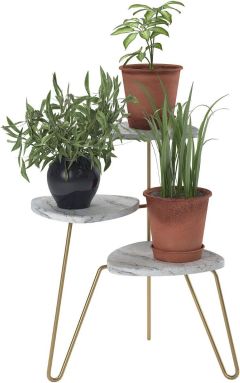
Sturdy indoor plant stand with a design perfect for any room.
Sturdy indoor plant stand with a design perfect for any room.
Strong triple-tiered plant stand for displaying greenery. This product is sold in black or white marble—an elegant option for your space, with each part of the stand holding up to 4 pounds.
Some aren’t fans of the laminated surface.
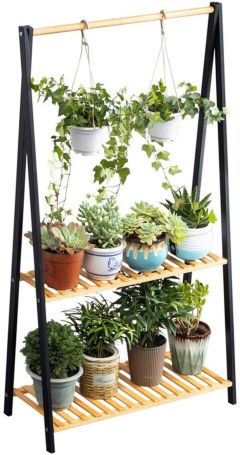
A versatile option that is ideal for any space.
A versatile option that is ideal for any space.
Perfect for hanging plants and easy to use indoors and outdoors. It features a rod for hanging items, as well as two shelves for storing other plants. Made of iron and bamboo with a functional design.
Keep in mind that there’s only so much space between the hanging rod and the first shelf.
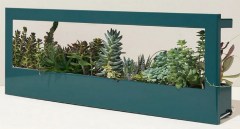
More than a plant stand, this mountable frame with a light is a growing system that's suitable for succulents and other small plants.
More than a plant stand, this mountable frame with a light is a growing system that's suitable for succulents and other small plants.
Modern frame design can be mounted on a wall. Saves space and makes a nice conversation piece. Built-in grow light helps plants thrive yet doesn't use an excessive amount of energy.
Won't work for large plants. Pricey.

You can display small and midsize plants in style with this eco-friendly 2-in-1 stand and planter.
You can display small and midsize plants in style with this eco-friendly 2-in-1 stand and planter.
Stand with a planter made with natural and sustainable bamboo wood fibers. The stylish design looks great in any room. The planter has a hole for drainage and includes a stopper. Affordable.
The planter won't accommodate plants with large root systems.
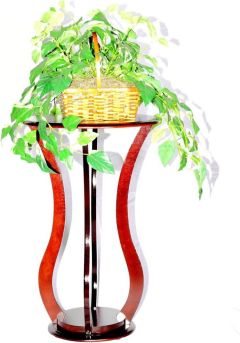
Straightforward indoor plant stand that is easy to use.
Straightforward indoor plant stand that is easy to use.
Simple plant stand from a trusted company. Space for one or two plants. Nice design that doesn’t require much setup. A classic color that will go with almost any room.
Some say it can be a bit flimsy, so check the surface you will place it on.

We recommend these products based on an intensive research process that's designed to cut through the noise and find the top products in this space. Guided by experts, we spend hours looking into the factors that matter, to bring you these selections.
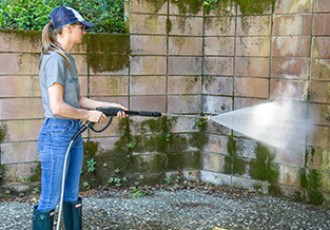
Whether you’re just starting to grow a few houseplants or have been caring for indoor plants for years, you need a place for them that keeps them healthy and safe, as well as displays them to their best advantage. If you’re ready to move your houseplants off countertops, floors, and end tables, you’re ready for an indoor plant stand.
The benefits of growing and caring for houseplants are well known, ranging from stress reduction to improved air quality. An indoor plant stand helps you to better organize your plants and position them in the best possible light, literally and figuratively.
When shopping for an indoor plant stand, there are a number of factors to consider, from style and capacity to size and price.

When we talk about the capacity of an indoor plant stand, we’re talking about a few different factors from quantity to size to weight.
How many plants do you have? If you have many houseplants, you need a stand with several tiers or shelves to properly display them all.
How large are your plants? Houseplants and their pots come in a variety of sizes. Whether you’re partial to tiny succulents, giant ferns, or something in between, you need an indoor plant stand with shelves that can accommodate your plants and pots.
How much do your plants and pots weigh? The shelves on your indoor plant stand need to be able to support the weight of the plants and their pots. Weight capacity varies greatly: some stands can support 50 pounds or more. Weigh your potted plants on a bathroom scale before ordering a plant stand so you know the total weight that the stand needs to support.
Another factor to consider is the size of the indoor plant stand. Generally speaking, the larger the stand, the more plants it can hold. However, a larger stand takes up more space in your home, which could be an issue if you have limited space. Be sure to measure the space where you intend to put your plant stand before ordering it. In addition to the width and length of the stand, also note the height and take into account the height of any plants you want to put on the top shelf of the stand.
You don’t want an indoor plant stand that is so flimsy that it could potentially tip over, leaving you with a mess of soil, broken pots, and damaged plants. Pay particular attention to the weight capacity (mentioned above) and don’t exceed it. If your plants are heavy, look for a heavier stand with a wide, stable base. A pyramid-shaped stand is one way to concentrate the weight for better stability.

Most indoor plant stands are made of wood, metal, or plastic.
Wood: You’ll find wooden indoor plant stands made of attractive, durable hardwoods like oak and lighter, less durable wood like bamboo. Some are made of plywood and other types of manufactured wood. Wooden indoor plant stands are usually multitiered and fairly lightweight. Some are pretreated to be more water-resistant.
Metal: You’ll find durable and long-lasting indoor plant stands made of wrought iron, steel, and aluminum. They are heavier than wooden models, particularly those made of iron. Some metal stands are powder-coated to protect them from moisture, prevent rust, and improve their overall durability.
Plastic: Less common are plastic indoor plant stands. While inexpensive and lightweight, they are also less durable and many look cheap.
Tiers/shelves: Indoor plant stands can have from one tier or shelf to a dozen or more at different levels. The more shelves, the more plants you can display. Many wooden stands, in particular, have a variety of tiers for displaying numerous plants. All the shelves should be durable and level.
Feet: While not all indoor plant stands have feet, some (metal, in particular) have rubber or felt feet to help protect hardwood and other flooring in addition to preventing the stand from sliding around.
Indoor plant stands are obviously functional, but they can also be decorative. You might gravitate toward a simple or basic design or seek a unique, ornate stand. Indoor plant stands range from rustic to modern to elaborate in a variety of colors and with all sorts of decorative elements. Your choice, of course, will be based on the décor in the room and your own aesthetic.

Inexpensive: The indoor plant stands that cost less than $25 are simple, often capable of supporting a single plant. While some stands in this range can hold multiple plants, they are usually only capable of supporting small pots.
Mid-range: The size of indoor plant stands increases with the price. Stands in the $25 to $40 range are larger and more durable. Multitiered wooden stands are common here.
Expensive: Indoor plant stands that cost over $40 tend to be large multitiered wooden stands or elaborately designed metal stands. Indoor plant stands that cost over $100 are highly decorative, durable, and usually made of metal.


A. There are two primary factors to consider when deciding what size indoor plant stand to purchase: available space and the number of plants. If you live in a tiny apartment, a large plant stand could easily overwhelm it. Measure your available space before deciding on a specific stand. If you only have one or two plants, a large stand would be overkill unless you’re also going to display additional items on it, such as books, candles, and photos.
A. In some cases, moving houseplants outside during the summer is beneficial to the plants and helps to liven up your deck or other outdoor living space. If this is your goal, be sure that any plant stand you buy is able to move with your plants. Plastic can usually be used either inside or outside. If you have a metal or wooden plant stand, it needs to be water-resistant or waterproof, so make sure a metal stand is powder coated and a wooden stand is treated in some way. While many metal stands are already weather-resistant, you could be on your own in terms of protecting a wooden stand.
A. Some indoor plant stands ship fully assembled, while others require assembly. Even if you do have to put it together, it isn’t as complicated as an entertainment center. Any assembly should be easily manageable. Read through the product description and included instructions to verify that you understand what’s required to put the stand together. Also check that all the hardware or other parts are included, and you have all the tools you need. If any step is unclear, reach out to the seller with any questions.
Get emails you’ll love.
Learn about the products you’re wondering if you should buy and get advice on using your latest purchases.
BestReviews wants to be better. Please take our 3-minute survey,
and give us feedback about your visit today.
